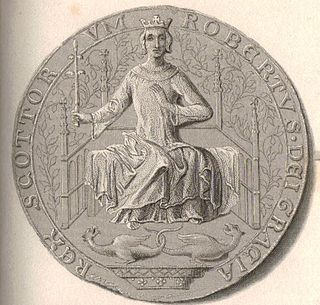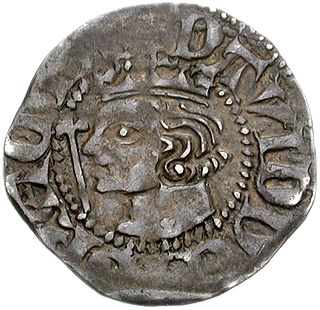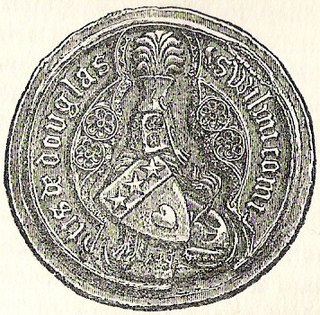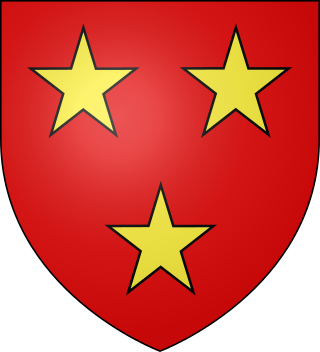Related Research Articles

Robert II was King of Scots from 1371 to his death in 1390. The son of Walter Stewart, 6th High Steward of Scotland, and Marjorie, daughter of King Robert the Bruce, he was the first monarch of the House of Stewart. Upon the death of his uncle David II, Robert succeeded to the throne.

David II was King of Scotland from 1329 until his death in 1371. Upon the death of his father, Robert the Bruce, David succeeded to the throne at the age of five and was crowned at Scone in November 1331, becoming the first Scottish monarch to be anointed at his coronation. During his childhood, David was governed by a series of guardians, and Edward III of England sought to take advantage of David's minority by supporting an invasion of Scotland by Edward Balliol, beginning the Second War of Scottish Independence. Following the English victory at the Battle of Halidon Hill in 1333, King David, Queen Joan and the rump of his government were evacuated to France, where he remained in exile until it was safe for him to return to Scotland in 1341.

The title Earl of Morton was created in the Peerage of Scotland in 1458 for James Douglas of Dalkeith. Along with it, the title Lord Aberdour was granted. This latter title is the courtesy title for the eldest son and heir to the Earl of Morton.

Hermitage Castle is a semi-ruined castle in the border region of Scotland. It stands in the remote valley of the Hermitage Water, part of Liddesdale in Roxburghshire. It is under the care of Historic Scotland. The castle has a reputation, both from its history and its appearance, as one of the most sinister and atmospheric castles in Scotland.

Archibald Douglas, 5th Earl of Angus was a Scottish nobleman, peer, politician, and magnate. Tradition has accorded him the nickname Archibald 'Bell-the-Cat' due to his association with the 1482 rebellion against James III of Scotland. He became one of the most powerful nobleman in Scotland through his influential position on the Scottish Marches, and a willingness to be involved in multiple rebellions in the reigns of James III and James IV of Scotland.
Sir Alexander Ramsay of Dalhousie was a Scottish nobleman and knight who fought for David II, King of Scots in the south of Scotland in the Second War of Scottish Independence. He is remembered especially for his actions during the siege of Roxburgh Castle.

Liddesdale, the valley of the Liddel Water, in the County of Roxburgh, southern Scotland, extends in a south-westerly direction from the vicinity of Peel Fell to the River Esk, a distance of 21 miles (34 km). The Waverley route of the North British Railway ran down the dale, and the Catrail, or Picts' Dyke, crosses its head.

William Douglas, 1st Earl of Douglas was a Scottish nobleman, peer, magnate, and head of the Black Douglas family. Under his leadership, the Black Douglases continued their climb to pre-eminence in Scottish politics begun under his uncle, Sir James the Good, as well as their military dominance of the south of Scotland.
Sir Archibald Douglas was a Scottish nobleman, Guardian of Scotland, and military leader. He is sometimes given the epithet "Tyneman", but this may be a reference to his great-nephew Archibald Douglas, 4th Earl of Douglas. He fought and died at the Battle of Halidon Hill.
Holders of the office of Lord Chamberlain of Scotland are known from about 1124. It was ranked by King Malcolm as the third great Officer of State, called Camerarius Domini Regis, and had a salary of £200 per annum allotted to him. He anciently collected the revenues of the Crown, at least before Scotland had a Treasurer, of which office there is no vestige until the restoration of King James I when he disbursed the money necessary for the maintenance of the King's Household.

Sir William Douglas, Lord of Liddesdale, also known as the Knight of Liddesdale and the Flower of Chivalry, was a Scottish nobleman and soldier active during the Second War of Scottish Independence.
Maurice de Moravia, Earl of Strathearn (1276–1346), also known as Maurice Moray or Murray, was a Scottish nobleman.

The Lord of Liddesdale was a magnate in the medieval Kingdom of Scotland; the territorial lordship of Liddesdale was first created by David I of Scotland, perhaps between 1113 and 1124 when the latter was Prince of the Cumbrians. From an early period the caput of the lordship was Hermitage Castle, the strength of Liddesdale. King David gave the territory to Ranulf de Soules, a knight from the Cotentin Peninsula. It was forfeited by the Soulis family in the 14th century and eventually passed to the Douglases, only to be lost to the Hepburns by order of James IV. Archibald Douglas, 5th Earl of Angus was remunerated for this loss by the lordship of Bothwell Castle, although the Hepburn Earls of Bothwell retained the territorial designation

William de Moravia was the 5th Earl of Sutherland and chief of the Clan Sutherland, a Scottish clan of the Scottish Highlands. William, 5th Earl of Sutherland was a loyal supporter of David II of Scotland in the wars against England.
James Douglas, 1st Lord Dalkeith was a Scottish nobleman born in Dalkeith, Midlothian, Scotland to Sir James Douglas and Agnes Dunbar. James was the brother of Nicholas Douglas, 1st Lord of Mains.
Cupar Castle was a royal castle at Cupar, Fife, Scotland. It was located on a small hill or motte that is known as Castle Hill next to Castlehill Primary School in Cupar. No vestiges of the castle remain above ground.
Sir Andrew Murray (1298–1338), also known as Sir Andrew Moray, or Sir Andrew de Moray, was a Scottish military and political leader who supported King David II of Scotland against Edward Balliol and King Edward III of England during the Second War of Scottish Independence. He held the lordships of Avoch and Petty in north Scotland, and Bothwell in west-central Scotland. In 1326 he married Christina Bruce, a sister of King Robert I of Scotland. Murray was twice chosen as Guardian of Scotland, first in 1332, and again from 1335 on his return to Scotland after his release from captivity in England. He held the guardianship until his death in 1338.
Events from the year 1342 in the Kingdom of Scotland.

Sir Robert de Ogle was an English soldier and feudal landowner in Northumbria who fought in the border conflicts with Scotland. He captured five Scottish knights near Newcastle in 1341 and was licensed to crenellate Ogle House. He distinguished himself in resisting the foray into Cumberland of Sir William Douglas in 1345, fought at Neville's Cross in 1346 and took three nobles prisoner, and held Berwick Castle against the Scots in 1355.
The Siege of Perth was conducted from June–August 1339 as part of the Wars of Scottish Independence. The siege was conducted by forces loyal to David II of Scotland and commanded by Robert Stewart, the Guardian of Scotland. The defending forces were acting on behalf of Edward Balliol and were commanded by Thomas Ughtred.
References
- ↑ Penman, Michael (2008). David II. East Linton, Scotland: Tuckwell Press Ltd. p. 90.
- Americanized Encyclopedia Britannica, Revised and Amended: A Dictionary of Arts, Sciences and Literature; to which is Added Biographies of Livings Subjects.
Volume 9. The "Examiner", 1890.